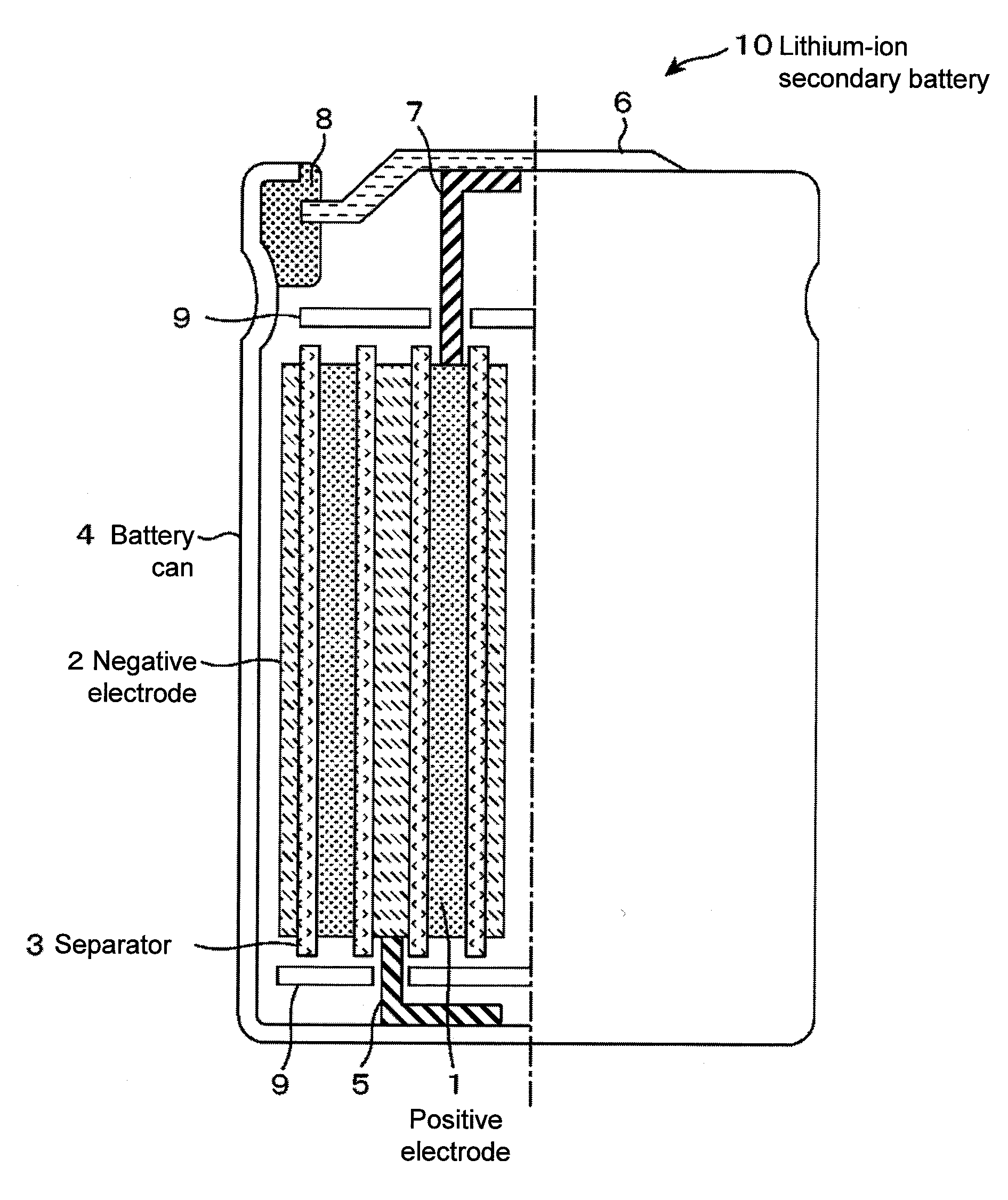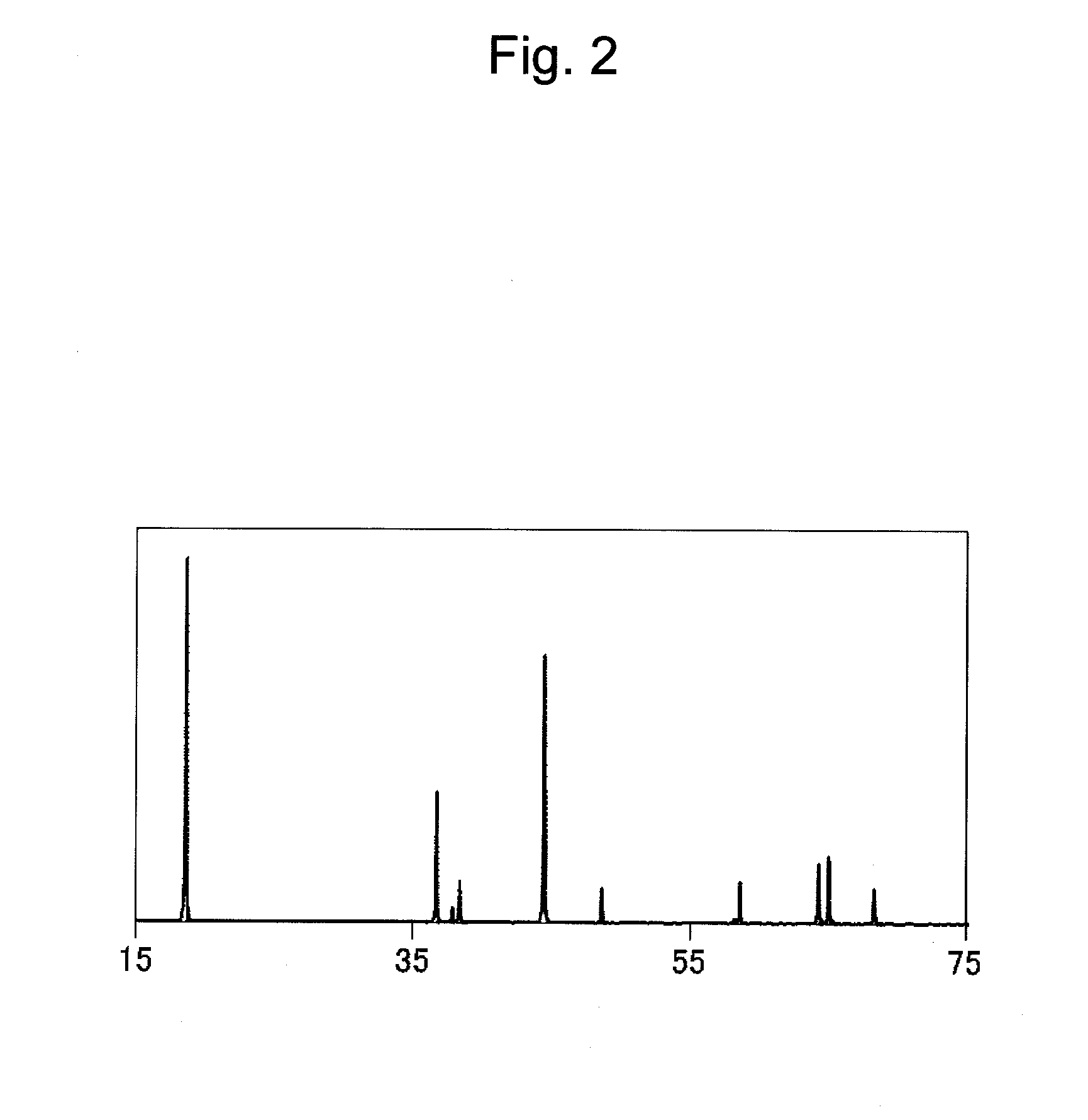Positive electrode material for lithium-ion secondary battery, lithium-ion secondary battery and secondary battery module using the same
a lithium-ion secondary battery and lithium-ion secondary battery technology, applied in the field of lithium-ion secondary batteries, can solve the problems of insufficient thermostability, desorption of oxygen, and inability to improve thermostability, and achieve excellent thermostability and excellent safety during charging.
- Summary
- Abstract
- Description
- Claims
- Application Information
AI Technical Summary
Benefits of technology
Problems solved by technology
Method used
Image
Examples
example 1
[0104]Table 1 shows properties of the composite oxide of the positive electrode produced in Example 1.
TABLE 1AtomicAtomicconcentrationProportionCoatingconcentrationof P on theProportionoflayerof P on thecompositeof Li3PO4CompoundCompositeLiMnXM1−XO2thicknessouter sideoxide side(% byM (% byExothermicoxidexMA(nm)(atom %)(atom %)weight)weight)peak (° C.)Example 10.2Li, Ni,Al309310.4265Co
(Production of a Positive Electrode Material)
[0105]In Example 1, lithium carbonate (LiCO3), manganese oxide (MnO2), nickel oxide (NiO), and cobalt oxide (CoO) were used as starting materials for a composite oxide. The starting materials were weighed at a ratio of Li:Mn:Ni:Co of 1.04:0.20:0.38:0.38, followed by wet pulverization using a pulverizer and mixing. The obtained powder was dried, introduced into a high-purity alumina container, and then subjected to preliminary calcination in the air at 600° C. for 10 hours to improve sintering performance, followed by air cooling. Next, the powder subjected to...
example 2
[0132]In Example 2, a composite oxide was produced as in the case of Example 1 except that a surface-modified composite oxide was produced by carrying out heat treatment in a nitrogen trifluoride gas (NF3) atmosphere but not in the air after surface treatment.
[0133]In Example 2, the coating layer thickness was 30 nm. The mean concentration of P on the outer side (i.e., the electrolyte side) of the coating layer was found to be 9 atom % while the mean concentration of P on the composite oxide side of such layer was found to be 3 atom %. Electron diffraction images of the coating compounds containing P and Al in the coating layer corresponded to Li3PO4 (ICDD: No. 15-760) and γ-Al2O3 (ICDD: No. 10-425), respectively. As a result of calculation by ICP analysis of the surface-modified composite oxide, the proportions of the compounds P and Al in the coating layer relative to the proportion of the composite oxide were found to be 1.0% by weight and 0.4% by weight, respectively. In additio...
example 3
[0137]In Example 3, a composite oxide was produced as in the case of Example 1 except that a surface-modified composite oxide was produced using, as starting materials for surface treatment, magnesium nitrate (Mg(NO3)2) (7.5 g) and lithium hydroxide (2.5 g) instead of aluminum nitrate (3.0 g) and lithium hydroxide (1.0 g).
[0138]In Example 3, the coating layer thickness was 60 nm The mean concentration of P on the outer side (i.e., the electrolyte side) of the coating layer was found to be 12 atom % while the mean concentration of P on the composite oxide side of such layer was found to be 4 atom %. Electron diffraction images of the coating compounds containing P and Al and forming the coating layer corresponded to Li3PO4 (ICDD: No. 15-760) and γ-Al2O3 (ICDD: No. 10-425), respectively. As a result of calculation by ICP analysis of the surface-modified composite oxide, the proportions of the compounds P and Al in the coating layer relative to the proportion of the composite oxide wer...
PUM
 Login to View More
Login to View More Abstract
Description
Claims
Application Information
 Login to View More
Login to View More - R&D
- Intellectual Property
- Life Sciences
- Materials
- Tech Scout
- Unparalleled Data Quality
- Higher Quality Content
- 60% Fewer Hallucinations
Browse by: Latest US Patents, China's latest patents, Technical Efficacy Thesaurus, Application Domain, Technology Topic, Popular Technical Reports.
© 2025 PatSnap. All rights reserved.Legal|Privacy policy|Modern Slavery Act Transparency Statement|Sitemap|About US| Contact US: help@patsnap.com



